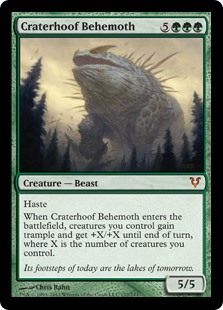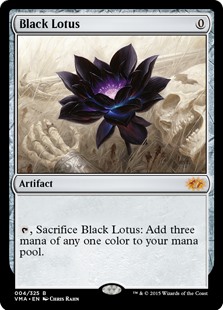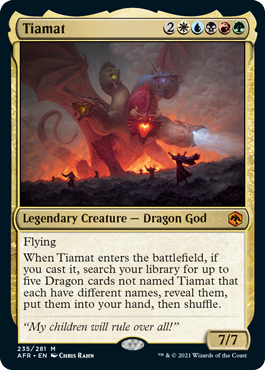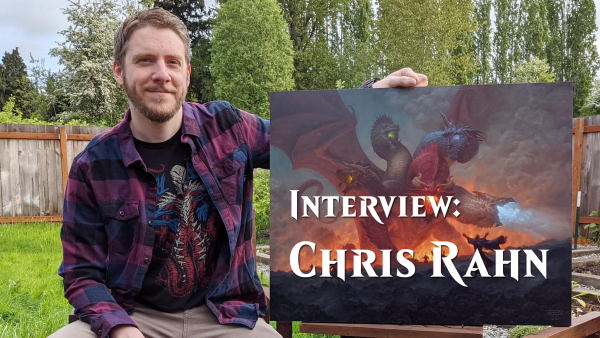Magic: The Gathering artist Chris Rahn joins Magic Untapped for a Q&A.
Currently hailing from the town of Puyallup, Wash., Chris Rahn has had an eclectic art career. Yes, he has done work for the Magic: The Gathering collectible card game, even going so far as creating art for the newest version of the game's iconic card, Black Lotus. But he has also done a lot more. including works for Marvel, Hearthstone, Dungeons & Dragons, Valve, even The Village Voice.
And, even with such a full plate, Chris Rahn was kind enough to take some time out of his busy schedule to answer some of our questions.
Magic Untapped: What inspirations and influences in your life drove you to becoming a professional artist?
Chris Rahn: I was always drawing from a really early age. At first it was monster trucks and Ninja Turtles, then comic book characters. Then my older brother and his friend got me into MTG when I was bout 10. I only played for a few years but it got me into fantasy art which kind of took over my mind. Eventually I quit playing MtG because I was more focused on art but it definitely played a role in my development, along with lots of other sci-fi/fantasy/horror media.
MU: You went to the Academy of Art in San Francisco where some of your fellow Magic artists (Daarken, Jason Chan, and Tyler Jacobson, to name a few) also went. Did any of you ever happen to cross paths with them and what's with that school in specific that's helped to create so many well known MTG artists?
CR: It's funny, we didn't know each other at all. I had one friend in common with Tyler (Ray Bonilla, in case he's reading this) but we never met, we are good buddies now though. I remember seeing Daarken and Jason around from time to time but I think they were a year ahead of me. We never really got a chance to talk. To answer your second question, it's a good school with a lot of highly skilled instructors (Stephen Player, Kazu Sano, Chuck Pyle, etc). It's also a very large school, I think there were 500 kids in the illustration program when I was there so some of it is just numbers.
 MU: A number of the cards for which you've created artwork such as Craterhoof Behemoth, Cyclonic Rift, and Sword of Fire and Ice have gone on to become rather popular and powerful, seeing a lot of play in both casual and tournament scenes. As an artist, does this change how you view your specific completed works compared to those on cards that don't wind up being so popular with players?
MU: A number of the cards for which you've created artwork such as Craterhoof Behemoth, Cyclonic Rift, and Sword of Fire and Ice have gone on to become rather popular and powerful, seeing a lot of play in both casual and tournament scenes. As an artist, does this change how you view your specific completed works compared to those on cards that don't wind up being so popular with players?
CR: That is an interesting question...on the one hand you come to appreciate that people really like the image because it's associated with their positive experiences with the card, also good print and artist proof sales do make you think more positively of a piece in a way. But you also get so tired of looking at the same few pieces over and over when signing them. In reality a lot of my favorite pieces were on bad cards that I rarely see. Those are the few original paintings that I kept as well.
MU: How long do you typically spend on a piece?
CR: 2-4 days on development (sketching, final drawing, etc), 4-6 days on the final painting.
MU: Have you ever tried a more "out of the box" approach to a card where you try a new perspective or style?
CR: Yeah, I do try to push myself when the opportunity arises. Time Walk was an example of that. A lot of my experimenting is subtle stuff though, like a different lighting scheme or limited color palette. Not something a casual observer would pick up on.
 MU: In 2012, you were given the opportunity to do new artwork for not just one, but two of Magic's most iconic cards, Black Lotus and Time Walk. Was the experience different than any of the other Magic artwork you've created in any way?
MU: In 2012, you were given the opportunity to do new artwork for not just one, but two of Magic's most iconic cards, Black Lotus and Time Walk. Was the experience different than any of the other Magic artwork you've created in any way?
CR: I was actually blissfully ignorant about the importance of Time Walk when I painted it but I knew what it meant when I got the Black Lotus. I spent a lot of time planning that one out (mostly because I was terrified to screw it up, haha). The sketch I submitted was actually pretty different than what they suggested in the assignment but they really liked the direction and let me go for it.
MU: Do you have a favorite art medium? If so, does it make fantasy artwork harder or easier to create?
CR: Yeah, I only do final art in oils. I used to do digital finals sometimes but eventually went to oils only. It's the medium that's closest to how my brain works. Everything else is a bit of a struggle. It can be challenging managing drying times with oils but you get used to it.
U: What kinds of things are more tricky for you to create (landscapes, people creatures, etc.)?
CR: Spells. Doing translucent magical effects in oils is a mind-bender.
 MU: You're still quite active in creating artwork for Magic: The Gathering with a handful of cards in the recently released Adventures in the Forgotten Realms set such as Adult Gold Dragon and Tiamat. Safe to say players can expect more cards illustrated by you going forward?
MU: You're still quite active in creating artwork for Magic: The Gathering with a handful of cards in the recently released Adventures in the Forgotten Realms set such as Adult Gold Dragon and Tiamat. Safe to say players can expect more cards illustrated by you going forward?
CR: Absolutely, expect a lot of wild stuff in the future.
Thank you to Chris for participating in this interview.









